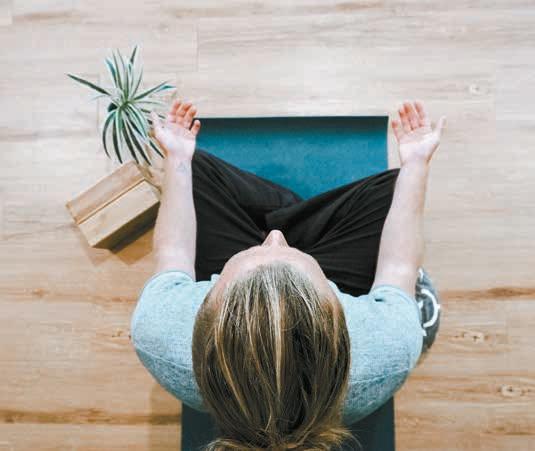
10 minute read
SING TO HEAL
SING TO HEAL Using the Voice to Uplift Mind and Body
by Marlaina Donato
Advertisement
According to growing research, singing along to a favorite musical or joining a local choir can be good for our health. From college students to patients with Parkinson’s disease, everyone can benefit, regardless of talent. Singing naturally fosters endorphins, amps up immunity levels and lowers the stress hormone cortisol. A study by the UK University of East Anglia published in 2017 in The BMJ’s Medical Humanities shows that group singing—along with the positivity of social interaction— supports and improves mental health in people with depression and anxiety. Singing for the Brain, a program created by The Alzheimer’s Society, has been shown to improve memory, mood and the ability to socialize for people with dementia.
“I feel singing can be significant to mental well-being and healing from an injury or cancer, while in recovery from substance abuse, or to help cope with trauma. Additional benefits may include pain management,” says Tamera Anderson-Hanna, a licensed mental health counselor and the owner of Wellness, Therapy & Yoga, in Miami.
Breathing into Self-Expression
“When we sing, we dive straight into a conscious bodily experience that brings us into immediate connection with our bodies. Singing, especially repetitive singing where we can start to regulate a breath cycle and elongate it, gets us deeply oxygenated,” says Daisy Press, a professional singer and vocal teacher in New York City.
There’s no right or wrong way to reap the benefits of music. A few years into her professional career, Press took a group lesson with a North Indian raga teacher and experienced a deep inner shift. “I was allowed to enjoy the feeling of singing that one note and my mind turned off. I felt the intonation itself in my body—in waves, shapes and colors. Intonation itself became a real living energy that felt essentially good, restorative and healing.”
Lea Longo, a Montreal-based meditation mindfulness coach and musician, concurs. “Singing has been my way to relax, not only my mind, but my body, as well. It uses the breath, a vital tool for health. It’s my go-to place to feel better. I just sing when I need a boost, and it works for me.”
Resonance, Mantra and Humming
“The voice can be considered a healing tool for the fact that it is directly related to resonance in the body,” explains Longo. “We can think of our voice as a tuning fork to ‘tune’ ourselves and use it as a way to heal internally through the vibrations and sounds we produce.” Using sound is a subtle energy therapy that can help heal emotional or physical distress, he says.
Mantra, the recitation of specific words or traditionally sacred chants, is not a religion, but simply a method to quell mental chatter. “Mantras are vibrational tools that can be practiced by any faith or spiritual practice.”
In her work, Anderson-Hanna makes the mantra personal. “I often teach individuals how to create their own mantra
and how to challenge their thinking using positive affi rmations. Th e mantra I teach is most oft en a personal refl ection of ‘I am’ statements they can aspire to, versus negative or defeating thoughts.”
Humming, another way to open the voice for healing, is the least intimidating for many people, but packs a powerful punch. “Out of all the many healing sounds I’ve worked with, I fi nd that humming is the most eff ective because it is so inclusive—everyone can hum. Physiologically, humming reduces heart rate, respiration and blood pressure. Many diff erent benefi cial hormones and chemicals are released, including endorphins, oxytocin, melatonin and nitric oxide,” says Jonathan Goldman, co-author of Th e Humming Eff ect and director of the Sound Healers Association, in Boulder, Colorado. “Th e importance of nitric oxide is coming more into light since it is a vasodilator and has anti-viral qualities.” In addition, humming stimulates the vagus nerve, which reduces infl ammation and enhances immunity.
Whether we sing children to sleep at night or learn to sing jazz, using our voices can be good medicine. Goldman reminds us, “Th ere are so many diff erent ways that sound can positively shift and change us.”
Marlaina Donato is a recording artist and author. Connect at AutumnEmbersMusic.com.
Starting Off Singing Humming and Singing Tips to Try
From Tamera Anderson-Hanna, an Uplift ing Playlist:
“I encourage my clients if they need to boost their mood to create a happy and uplift ing playlist to sing or listen to—the same advice I used for myself when healing from breast cancer and experiencing setbacks.”
From Jonathan Goldman, Conscious Humming:
“Find a place where you will not be disturbed. Begin by taking some nice deep breaths in and out. Choose a purpose or intention. Do you want to assist with a headache? Do you want to reduce your stress? Do you want to send this sound to a specifi c part of your body? Hum a tone on one note that is comfortable. Do this at least fi ve times so that you can become aware of how the hum is resonating in your head or body, and then hum for fi ve minutes, if possible. Be in a place of silence for at least a minute or more a er you have created the hum and be aware of what you experience. Note: Because the hum has so many powerful eff ects, people oft en become lightheaded (and very relaxed) when they practice conscious humming.”
From Lea Longo, Mantra Tips:
“If you have never used or chanted a mantra before, I would recommend starting with the universal mantra Aum or Om. It is simple and easy to pronounce. Start with fi ve minutes a day for 30 days and increase the time as you feel fi t. As you get more comfortable with the sound of your voice, you will develop a practice and habit. Th e shower is a great place to start to overcome self-consciousness.”
ACUPUNCTURE FACELIFT
A safe, effective, non-surgical procedure for facial rejuvenation and muscle toning. Stimulates and exercises the underlying facial muscles, creating a subtle, visible, contouring lift to firm and tighten the face and neck. Reduces lines and wrinkles. No scarring.

Terri Evans DOM, AP
Doctor of Oriental Medicine Esthetician Specializing in Healthy Aging Since 1991 430-6800
11983 Tamiami Tr N. 100A • Naples
TAEHealthyAging.com
Why weight... Be fit.
You can achieve your fitness goals in the safety of your own home. FrEE
Assessment & First session Specializing i n the over 6 0 po pul a t i o n .

GarY Kalman Full-time Certified Personal Trainer since 2005 www.weightbefit.com gmkalman@gmail.com • 201-923-5520
katerina jerabkova/Unsplash.com Mind-Body Fitness

How Mindfulness Benefits Workouts
by Marlaina Donato
When mindfulness approaches are applied to fitness training—which can be as simple as breathing consciously and tuning into subtle body sensations— the results can be fewer injuries, improved immunity, a lowered stress response, a brighter mood and a deeper commitment to staying fit. Being in the present moment can also spark enjoyment.
Research shows that mindfulness training can also significantly raise self-esteem, and women that cultivate meditative self-compassion experience a boost in acceptance of and satisfaction with their bodies.
“In nature, the bigger the eye of the storm, the more powerful the winds, suggesting that our workout potential and enjoyment is dependent not on how hard we push, but how calm and self-aware we can be,” says John Douillard, DC, author of Body, Mind, and Sport and the founder of LifeSpa, in Boulder, Colorado. “Slowing down and being aware of the body allows the mind to attend to muscles, which can increase blood supply, lymph drainage and replace a potentially damaging fight-or-flight response during a workout with a rejuvenating parasympathetic response.”
Tapping into Contentment
Mindful fitness instructor Ellen Barrett, in Washington Depot, Connecticut, offers clients a full-body experience with a fusion of movement forms and weight training. “We think mindfulness is some sort of yoga thing, but everything can become mindful. Jumping jacks and biceps curls can be mindful. It’s not the movement, but the awareness behind the movement. Mindfulness is about being present.”
Adding in balance training, tai chi and Pilates, and swapping a bit less time on the treadmill for a few moments of meditation or visualizing positive results can go a long way, say fitness experts. Debbie Rosas, founder and co-creator of Nia—a body-mind conditioning program anchored in martial arts and modern dance—underscores the importance of listening to cues. “Notice any areas that feel tight, blocked, rigid and bound. This wisdom through felt sense and awareness will immediately alert you to stop, adjust and slow down.”
The Portland-based co-author of The Nia Technique points to the fun factor. “I believe that when you stop exercising and start moving, anything you do can bring you enjoyment. Do things that leave you feeling successful and motivated to do them again.”
Breath as a Compass
Practicing conscious breathing fortifies the positive impact of exercise and can prevent injuries like hernias that can arise when the breath is held during heavy lifting. “One of the most powerful tools for mindfulness during a workout is following your breath. Mindfulness is the key, but it’s hard to be mindful when you’re breathing 26,000 times a day into the upper chest, activating a fight-or-flight response,” says Douillard.
Breathing through the nose instead of the mouth during exercise bolsters mindfulness, and as Douillard has demonstrated in studies, causes brain waves to shift from stressed beta waves to a meditative alpha state. “It takes longer to fully inhale and exhale during nose breathing, which creates a baseline of calm,” she says. “Don’t rush. Be aware of the body breathing and feel each muscle contracting and relaxing with each rep and stretch.”
Chicago-based fitness expert Stephanie Mansour, host of the PBS weekly
Step it Up with Steph show, concurs. “Sync your breath with your movement. Mindfully transition from exercise to exercise.” Mansour also suggests working out next to a mirror to improve alignment and avoiding the distraction that can come with having a workout buddy. “Another trick to improve form is to put on headphones and zone out by listening to white noise so that you have no distraction,” she says.
Exercising with deep body-presence is something we do for ourselves. “If you’re really paying attention, you can steer yourself towards invigoration and away from irritation. The body is always providing feedback, but we’re often too ‘out of body’ to notice. Giving full attention to your body is a big gift of self-love,” says Barrett.
“Breathe. Move. Be free,” adds Mansour. “Th is is your dedicated ‘me’ time and you can use it to feel good about yourself.”
Marlaina Donato is an author and composer. Connect at AutumnEmbersMusic.com.
Helpful Tip
Nasal breathing from John Douillard:
Establish a comfortable, slow, nasal breathing rhythm in the beginning of your workout and try to maintain that throughout your practice. Give it time. It will take about three weeks of nose breathing practice to begin to run at the same pace or lift the same weight as you did before as a fi ght-or-fl ight mouth breather.
To begin: Breathe deeply in and out through the nose with each rep on the weight machine and lengthen your nasal breathing during cardio [workouts]. As soon as your nasal breath rhythm begins to speed up or you have to open your mouth to breathe, slow down and reestablish a comfortable rhythm of nasal breathing again. Once the mindful calm has been reset, begin to increase your intensity, letting the nose breathing set the pace.
New for 2019: FREE oRganic mulch! One With Nature ~ Nurturing Our Planet One Lawn At A Time
MPV ORGANIC LAWN CARE Manuel Valdez Call 239-234-9299 5426 Carlton St. Naples, FL 34113 Visit MPVLandg.com for portfolio
analyze with video microscope
Suffering from hair loss? Scalp issues?
can help recommend track success treatments & products with before & after photos

~ NouriTress oxygeN scalp Therapy TreaTmeNT ~ Stimulates hair growth, hair loss prevention, and addresses scalp conditions such as dandruff & flaking, excess sebum (oily), & sensitivity. Strengthens hair roots, improves scalp circulation, promotes follicle stimulation, reduces scalp inflammation and assists with new hair growth!






